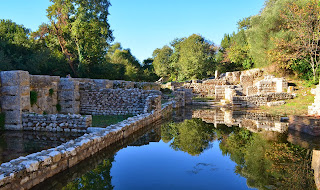We've visited a lot of ancient ruins during our time in Albania but the one that had eluded us to date is Butrint National Park. Located in the southern most part of the country where Albania, Greece, and the Ionian Sea meet (with spectacular views of Corfu, Greece on a clear day), this ancient settlement dates back to the 8th century BC. Today's excavated ruins span over two thousand years from Hellenistic temples of the 4th Century to the defenses against the Ottoman Empire of the 19th century. Like much of her Balkan counterparts, Butrint was at various times a thriving community, the scene of epic battles, and occupied by conquering forces. It is referenced in Virgil's epic poem The Aeneid and was visited by Julius Caesar and Augustus. During more modern times (19th century) it was a small fishing village and visited by foreign diplomats and tourists who were guests of Ali Pasha. Excavation of the ruins by Italian archaeologists began in 1928, it was recognized as a UNESCO World Heritage Site in 1992, and became a 86 square kilometer national park in 2001.
Now we hadn't not visited intentionally prior to our visit. On more than one occasion we had made plans to go but something always derailed them. First there was the long weekend where it rained (and who wants to be tromping around ruins in wet weather?). Then there was the time the major north-south route from Tirana to southern Albania closed because of the snow. (The drive takes you along the coast and up through Llogara Pass providing travelers with sweeping views of both the Adriatic and Ionian Seas. However, because of the elevation snow often closes the road). Our next attempt was on a beautiful early June day when neither rain nor snow was in the forecast. I thought we were good to go. And then I was told about the snakes. Yes, snakes. Butrint is located in a rather swampy location in Albania and when you combine these conditions with warm weather and piles of old rocks and put them in a country with its share of snakes, both venomous and not, you have conditions that this snake-a-phobe is not willing to risk. In 1959, before Albania severed her ties with the then Soviet Union, Nikita Khrushchev visited Albania and a tour of Butrint was on his itinerary. In preparation for this visit a new road was constructed into the site of the ruins and local villagers used saucers of toxic milk to poison the thousands of venomous snakes who called the ruins home. All I can say is eeewww! There are apparently not as many snakes now as there were half a century ago, but just the mere mention of them, and a warning from a fellow snake fearing co-worker aborted our plans yet again. But then again, I'd rather be safe than sorry.
With family in town last week we finally made the trip south to Butrint. The weather was perfectly clear and cool and because it was post-tourist season, we essentially had the park to ourselves. The signs warning of snakes and bugs at ticket booth were a bit unnerving but I warned Sidney to stay on the marked paths and off we went. The ruins were indeed impressive and we were able to walk through one century and into the next as we explored the surprisingly well maintained stone ruins. Standing in the 3rd century BC amphitheater surrounded by pools of water was pretty amazing as was the the 6th century baptistery and the Great Basilica from the same period. From the reconstructed 16th century Venetian castle situated at the top of the hill and Butrint's "high point", we had sweeping views of the bay and Corfu beyond. Walking along the perimeter wall along the shoreline we saw shirtless fishermen smoking with their bamboo poles in the water and herds of sheep grazing along the opposite shore. We also saw the uniquely Albanian car ferry transporting vehicles across the narrow channel. For me, it was one of those "only in Albania" moments where decades and centuries collide in a single event. The experience really was priceless and unforgettable.
 |
| Gateway to the amphitheater |
 |
| An archway with a view |
 |
| The Grand Basilica |
 |
| Corfu, Greece as a backdrop |
And yes because we were in Butrint we saw one snake. Granted it was only a small brown one we weren't able to identify as it slithered across the path in front of us, but the sighting was enough to freak me out. And as our mosquito bitten faces and arms attested too, the bugs were prevalent as well. The stories and signage were true but we had been warned. I guess you could say we had a true Butrint experience after all. But in the end the visit was well worth it, snakes and mosquitoes and all.

No comments:
Post a Comment